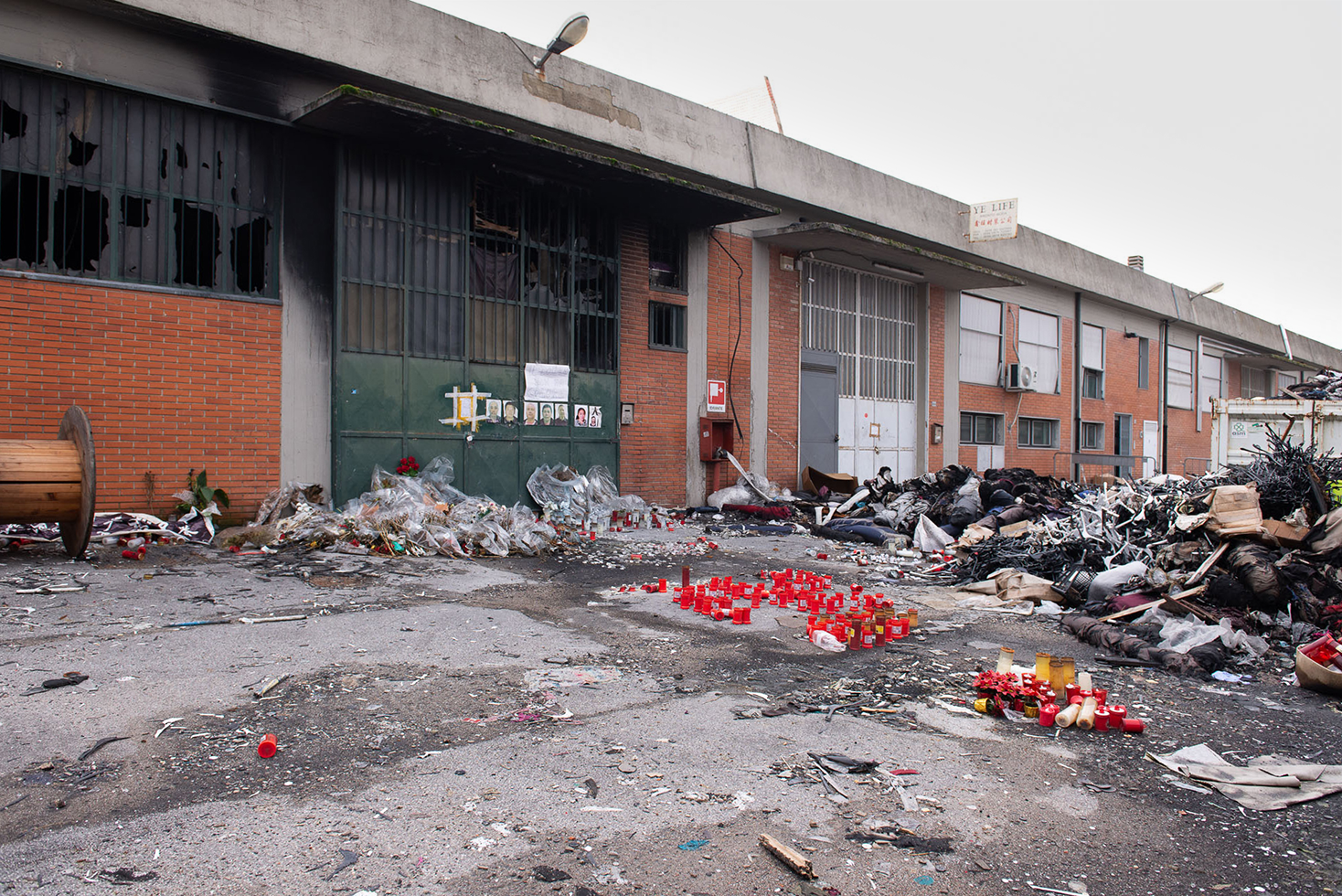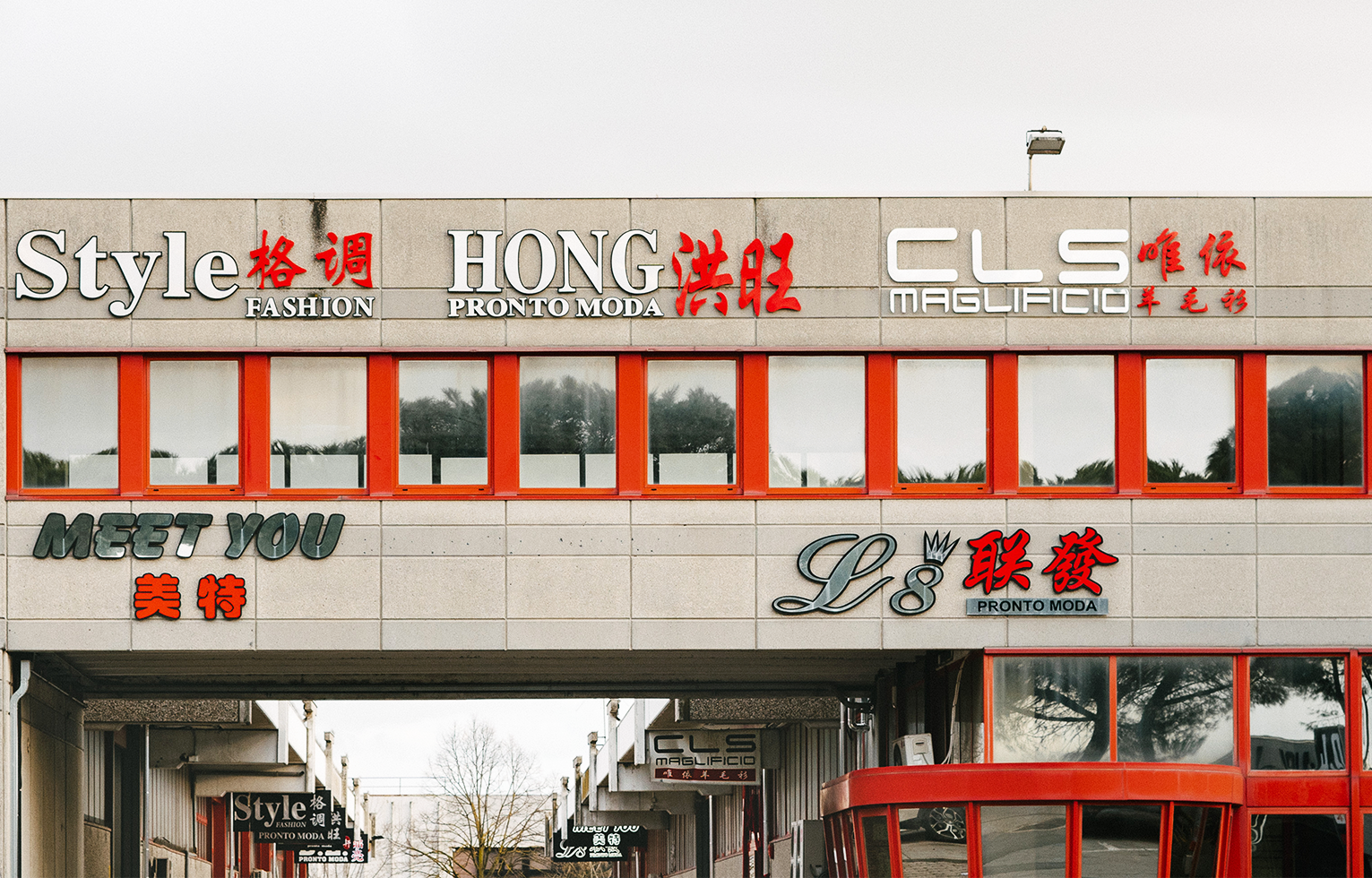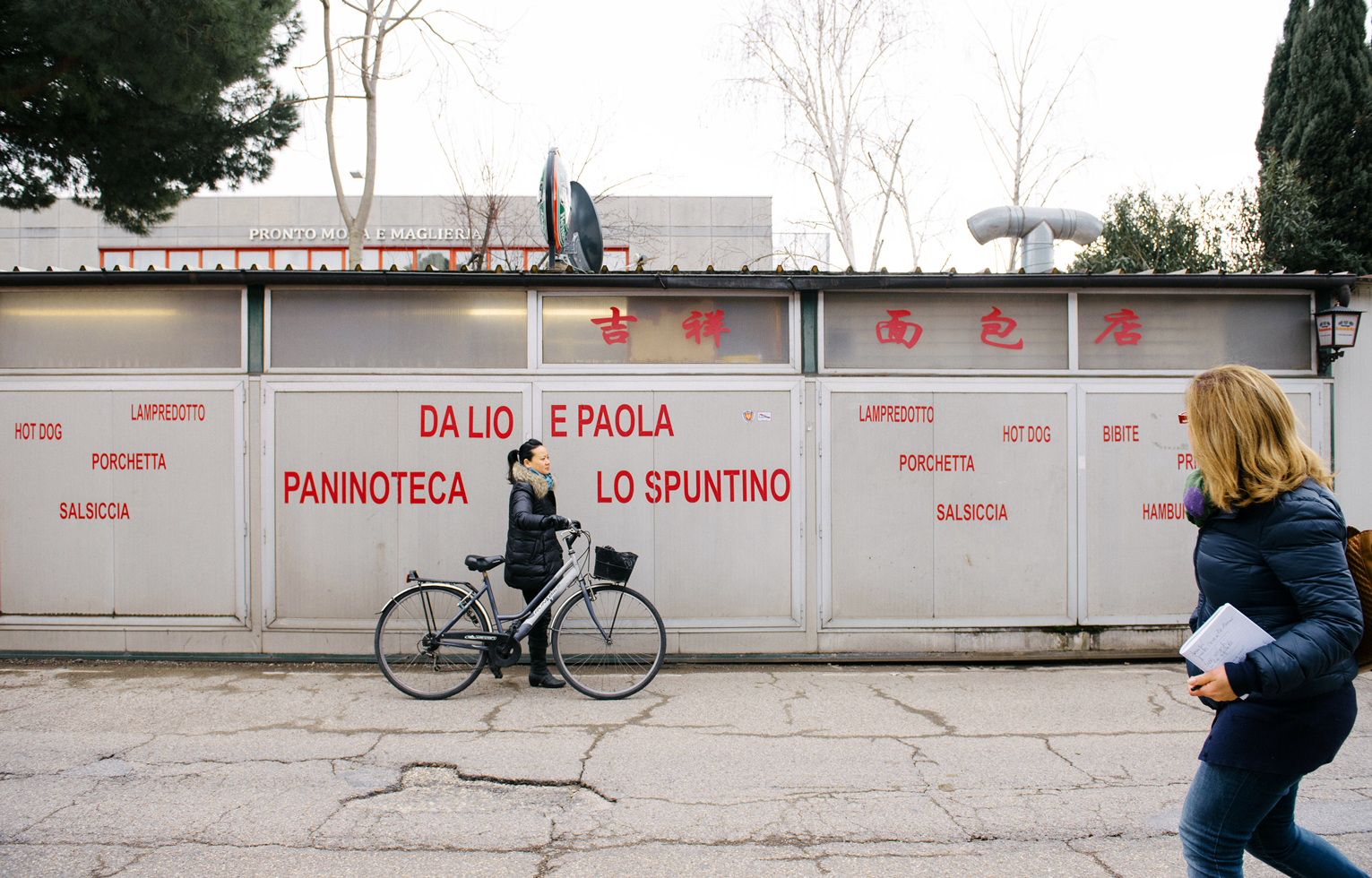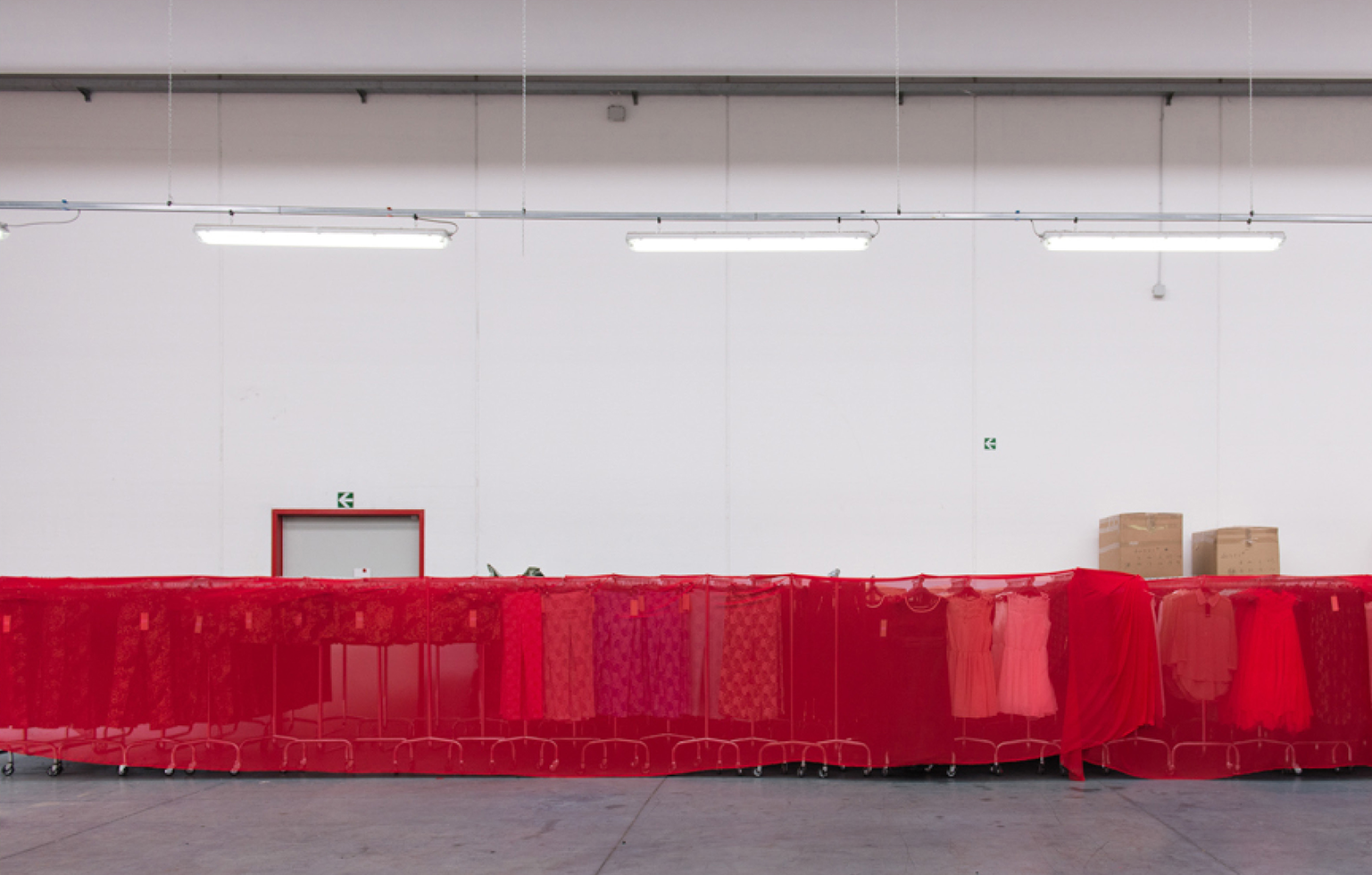Urbancopyleft* is a collective of researchers working at the intersection of human geography, architecture, and anthropology. All from Tuscany but with international backgrounds, we converged in 2020 at a time of great uncertainty to investigate hybrid strategies of place-making and started an animated discussion on issues related to diversity and cultural entanglements. We became immediately fascinated by the possibility of exploring certain contemporary urban challenges as they unfolded in Prato, a city in Tuscany with a population of 194,000 inhabitants, of which more than twenty percent are foreign-born.
More specifically, we focused on the neighborhood of Macrolotto 0, which is in many ways emblematic of the inextricable ties between industry, urban development, and migratory routes from China to Europe.1 The multiple representations of this area within local public discourse have made it a fitting metaphor for how cultural diversity has struggled to find recognition as a positive manifestation of global interconnectivity. This is the context in which we developed PratoTown—a digital platform based on physical observations, collective workshops, and performances that aims to account for the complex attempts to document, define, and narrate urban space and its global entanglements.
Apparent Dichtomies


Since the mid-1990s, Prato has been a key destination for migrants from the Chinese municipality of Wenzhou and its surrounding areas, who first established business operations in metropolitan Florence and then settled in nearby cities and towns including Prato and Macrolotto 0. They did so with entrepreneurial acumen and aspiration, taking advantage of this district’s strategic proximity to Prato’s city center as well as its unique mix of residential areas and large-scale warehouses, which at the time were being abandoned by Italian owners as a result of a slow phase of economic transition.2 Almost two decades later, when the 2008 global financial crisis hit—inevitably affecting the Italian manufacturing ecosystem—citizens of Chinese origin had already established their entrepreneurial ventures well beyond the limits of the neighborhood, consolidating their presence into the whole city.3
At the time of writing, the neighborhood’s connection to the complexities of global migration patterns have made it an area of significant interest. Its position in the context of a growing city like Prato is a much-debated topic. A number of initiatives promoted by the city’s administration have highlighted the symbolic centrality of the neighborhood related to strategies of urban development. At the same time, grassroots movements have attempted to orchestrate more collective forms of community engagement, also enabling the voices of second generation Chinese-Italians to emerge onto the scene. While the various claims made about representation by prominent Chinese community leaders have occasionally found sympathy and solidarity with progressive politicians, they have also been met with distrust by nostalgic industrialists fueled by populist sentiments. None of these narratives, however, have successfully overcome the frictions between various stakeholders invested in the narrative and representation of Macrolotto 0, as of today both an urban space determined by elements of significant decay and a laboratory of change for Tuscany’s regional and urban society.4
Towards an Nonbinary Understanding


Since the mid-2000s, Prato has become an important lens for studying migration on a small scale, a medium to explore the challenges and opportunities that the city’s growing multicultural population would pose to the administration.5 For this reason, Prato has made an attractive case study for many researchers and practitioners interested in its changing cultural makeup. A growing body of scholarship depicts a multi-faceted Sino-European reality, sometimes focusing on conflicting pathways to integration or on the growing relevance of the neighborhood at a European level.6 Yet even in this role of exemplar, in the collective imagination Macrolotto 0 has remained tied to instances of conflictual multiculturalism. In this sense, it is a typical case of how certain cultural frictions play out against the backdrop of a small (Italian) city.7
As contributions on both Prato and Macrolotto 0 populate various academic journals and media outlets, the approach to city-making adopted by the Prato administration has slowly moved towards a markedly participative model.8 One consequence of this is that Macrolotto 0 has become a choice location for creative experimentation: it is home to a number of photographic exhibitions and art residencies9 as well as temporary and permanent architectural interventions that have culminated in an ambitious project of urban upgrading known as Piano di Innovazione Urbana (Urban Innovation Plan).10 Far from assuming that creativity and innovation can be unproblematically adopted as transformative elements or that these factors can function autonomously through exploitative dynamics such as gentrification, we nevertheless believe the cultural and economic impulses that have recently been introduced to the neighborhood can multiply the practices used as well as the voices involved in the debate surrounding the directions that the socio-spatial development of Macrolotto 0 can undertake.
Alongside these developments, methodological reflections on how best to describe and intervene as urban practitioners with an interest in Macrolotto 0 have become more prominent. Recently, there has been a particular surge of interest in engaging in research practices in the neighborhood to empower previously silenced voices and identities: the use of innovative research processes that integrate quantitative and qualitative data collected through interdisciplinary approaches including digital participatory action research, for instance, has enabled the engendering and reinforcement of opportunities for migrants to become empowered city-makers.11
The project of PratoTown was framed by a shared interest in conceptualizing the dynamic shifts between place-making and city cultures, as well as new methodologies emerging from a context characterized by rapid infrastructural changes and the digitalization of research methods. As the name itself suggests, PratoTown is intended as a spontaneous toponymic crasis to expand the field of possible investigation.12 Crucial to our project has been the paradox represented by the multiplicity of the neighborhood’s identities and spatial cultures, which cannot easily be captured in a single representation.13 What is the “identity” of this place like? Can and should ethnicity be represented in place-making efforts, and who benefits from them? What stories and identities are neglected in this process?
Nuanced Realm(s), Faceted Signs




The digital repository
Macrolotto 0 has been targeted by multiple attempts at representation, each one undeniably situated in a specific cultural viewpoint, always with intentions to ameliorate it. Today, this condition is far from uncommon. Innumerable urban areas around the world also find themselves being defined by one-dimensional narratives that attempt to capture a generic idea of culture and place. Ethnicity is one of the channels through which this reductive spatialization of culture takes place; defining a culture in such a narrow way encloses it within bordered and confined areas. This is a brutal act of simplification, which effaces the heterogeneity inherent in every act of identification or attempt at understanding another culture.
As our conversations about the neighborhood intensified, we convened around a willingness to reject these narratives, which tend to assume that the identity of a place can be summed up not only in terms of its cultural essence, but also by grouping a certain number of individuals and creating a culture of profits that brings them all together. At the same time, we acknowledge that it is necessary to deal with the layered instances that we encounter in such a context: we need to embrace their potentials, problematize the controversies they generate, and find sophisticated, adequate languages that work on a discursive, visual, and spatial level.
By elaborating on the intersections among research, participatory processes, and design, we aim to start a new reflection on how to represent the liveliness of Macrolotto 0 in a way that does not overlook its heterogeneity or resort to cultural simplifications. We intend to adopt an operative and sustainable approach: our goal here is to engage with those whose voices have not yet surfaced in the public debate, whilst remaining open to the possibility of contestation: including cultural changes, emerging needs, and iterative feedback.14
As the most natural consequence of this layered approach, we have identified a digital repository as PratoTown’s main output, with the aim of co-creating new spatial languages through an innovative urban and participatory process. This open research tool uses data sources to inform social and cultural policies for the city, as well as more or less formalized urban practices. The primary data are creatively and collectively gathered through a research toolkit, namely a set of online surveys and physical performative probes.15 The platform collects, uploads, and allows access to a wide range of assets and material related to the district, from newspaper articles and artistic interventions in the area, to promotional websites, commercial goods, Youtubers’ explorations of the area, and other data. Combining a range of sources, the repository seeks to move beyond the limits of previous engagement and research approaches directed at the Chinese residents of the neighborhood. At the same time, PratoTown involves the non-Chinese population.
Through the analysis of building typologies, rituals, and behavioral patterns, a powerful architectural vocabulary emerges, characterized by hybrid iconographical instances: religious signs coexist with ordinary material finishings and elements of the textile process, while heterogeneous leftovers from specific celebrations highlight the unconventional use of certain industrial spaces. The hope is that this vocabulary will constitute an active palimpsest for interventions that are capable of eliciting different perceptions of public and productive spaces, which permeate the neighborhood.
Nonlinear Entanglements




The linguistic assemblages
We consider the unexpected overlaps between public gatherings and forms of industrial production as essential triggers for processes of identity formation within the context of the city. We just recently started to work within and about the neighborhood, but we believe that these overlaps are quite evident even to external—yet sensible and curious—observers. Peculiar superimpositions can already be detected firsthand in several parts of Macrolotto 0, and alternatively they can be augmented by creating representations that stitch together pieces of its urban fabric. To do this, we initially built a series of composite images; these will form the basis of a deeper discussion and analysis with representatives of the municipality, business owners, and citizens, all of whom have been brought together by the platform.
We provided a set of urban synesthesiae—visual diptychs where both panels contain spatial elements with entirely different origins, yet totally intertwined. For example, in figures 9 and 10, we underlined unexpected linguistic proximities, almost overlapping written sequences related to textile production (left panel) and food consumption (right panel) against the urban context in which they are located. In figures 11 and 12, the interiors of a fast fashion workshop (the typical architectural landscape of Prato’s textile factories) are taken over by decorations for the Lunar New Year parade (right panel)—creating a visual continuity with the Chinese dragon that is carried across the streets of Macrolotto 2 (left panel) by a dance team from an Italian martial arts gym. Through the juxtaposition of these images, we aim to develop nonlinear and nonbinary readings of the relations between hyphenated ethnicities and the public sphere, leading to a sensorial entanglement that stimulates perceptual capacity and conscious inventiveness. By directly involving the citizens in this process of linguistic detection and construction, asking them how to reflect upon increasingly complex spatial and visual assemblages, PratoTown marks a fundamental step in unveiling the transcultural nature of Macrolotto 0, reinforcing its heterogeneity as the main engine of Prato’s future urban development.
Urbancopyleft* comprises Andrea Del Bono, Rita Duina, Agnes Morganti, Sabrina Morreale, and Lorenzo Perri.